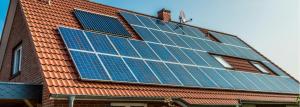Solar energy is a concept that we have pursued in recent years to try to find a better way to tackle the global energy supply problem without excessive damage to the environment. It is basically power obtained from the Sun which can then be converted into energy that we can use, such as electricity for thermal energy to heat or cool environments.
Either for environmental or financial reasons, people are increasingly switching their power needs to solar. Here is some helpful information to facilitate your transition.

Solar Energy: Understanding the Technology
Solar energy is mainly used to generate heat and produce hot water or electricity. The leading renewable technologies that make it possible to exploit solar rays’ energy are the photovoltaic panel, the solar thermal panel and the concentration solar panel.
Here are the main characteristics of each and how they work:
1) Solar Photovoltaic
The photovoltaic panel uses solar radiation to produce electricity through some semiconductor elements stimulated by light. More specifically, these are photovoltaic cells made of silicon that allow you to convert sunlight into electricity. This occurs through electrons, which, when light hits semiconductor materials, are channeled and thus produce an electric current.
Although this type of solar energy system does not operate continuously but only during the hours when sunlight can be used, it can meet the needs of mountain reservoirs and isolated areas thanks to high production [1].
2) Solar Thermal
The solar thermal panel is the technology that uses the Sun’s rays to heat the sanitary water contained inside it in a particular storage tank.
This system works via a solar collector. It heats a unique heat transfer fluid inside the pipes, characterized by insulating material that prevents overheating of its components.
Solar thermal collectors can be differentiated into two types: natural and forced circulation.
In the first case, the heat exchanger’s storage tanks are located above the heat panels where the liquid circulates. In contrast, in the second case, a pump is used to distribute the fluid in the exchanger and the panel, while the tank is located lower than the panels.
The use of solar thermal energy to produce energy essential for heating and cooling the devices allows an apparent reduction in air conditioning and space heating systems, decreasing the dependence on fossil fuels for the benefit of the environment [2].
3) Solar Concentrating
The concentrated solar system uses some parabolic mirrors to produce electricity from the Sun’s rays and provides heat at high temperatures.
Through concentrated solar panels, these systems concentrate all energy on a receiver tube containing the heat transfer fluid that transfers it into steam turbines to convert it into electricity.
In addition to the system of parabolic mirrors, known as point concentration, which is the most used, concentration solar can use flat mirrors positioned on the ground through which to convey the Sun’s rays towards the top of a tower (central tower system).
The concentrated solar system can also be linear parabolic, i.e., formed by parabolic tubes, therefore without cover, whose role is once again to heat the fluid contained in the pipes.
Solar Energy: the Main Advantages
In all its applications, solar energy offers countless economic benefits and ensures respect for the environment [3].
Here are the main advantages and disadvantages to consider before installing a system that uses solar energy.
1) Sustainability: the application of solar systems permits the generation of energy with low environmental effect since it does not need raw fossil materials to trigger combustion processes, therefore it does not release harmful substances into the atmosphere.
2) Endless resources: until the Sun goes out, we can use the energy that arrives on our planet at our convenience; in fact, the average irradiance that reaches the earth’s surface is equal to 1000 W for each square meter of cover and is available to us. When there are solar plants with yields that can exploit 70/80 percent of needs, photovoltaics will be the most used method for energy production.
3) Application Diversity: the energy from the Sun can be used in various ways: with a photovoltaic solar system, which converts the direct light towards the panels into electricity; with a solar thermal system, which allows you to use the heat from the Sun’s rays to heat a fluid, subsequently used for example to heat homes; with a thermodynamic solar system, which brings together the two characteristics of the first plants mentioned.
4) Low costs: despite a significant investment cost for the installation of a solar system, those who choose to focus on this technology will see the cost of the electricity bill fall sharply, will have the peace of mind of choosing green energy and will be able to trade their excess energy back to the national grid.
5) Tax relief: because of its environmental benefits, governments are incentivizing businesses and homeowners to make the switch to solar. For example, the Federal Solar Tax Credit can return as much as 25% of your solar installation costs on your federal income taxes. It’s always a good idea to check what kind of benefits are available at the state and municipal level as well.[4]
6) Ease of dismantling and reuse of photovoltaic panel components: unlike nuclear plants whose waste products are radioactive and difficult to store, solar plants do not create any waste. On the contrary, up to 95% of a single panel can be recycled and therefore have a shallow environmental impact [5].
Conclusion
In order to help transition the world into a green economy, we will need to take a deeper look at our energy consumption. One of the best ways to do that is by understanding the environmental and financial benefits of switching to solar energy. The best way to prepare yourself for a transition is by discovering what options are available to you, and the best place to start is with thorough research.
Lorecentral. “Pros and Cons of solar energy” Accessed 16 July 2020. https://www.lorecentral.org/2018/03/pros-and-cons-of-solar-energy.html
